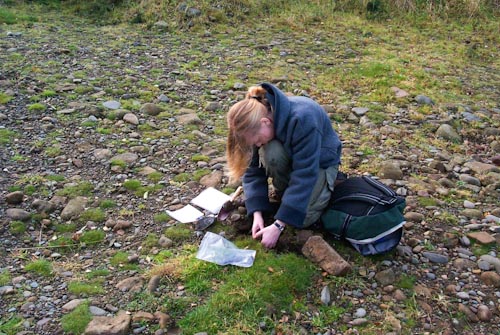
Lichens provide excellent subjects for advanced projects – they are present all year round and can be found in many habitats, both rural and urban, at sea-level, high altitudes, all latitudes and even in deserts.
Recent research shows lichens are excellent indicators of environmental quality and shifts in their occurrence may link with climate change. Reports in The Lichenologist, The Ecologist, Conservation Biology, British Wildlife and other journals provide further and more varied information.
Three very useful background books are:
- William Purvis Lichens (Natural History Museum, London)
- Oliver Gilbert Lichens (HarperCollins New Naturalist series)
- Judith Bell’s Doing your research project (McGrawHill – Open University).
See also Useful Links on this website.
A top-class project starts with a great idea, and this may come from a chance comment in a lecture, your own observations, or a report you have read. At degree and post-graduate levels defining your objective or hypothesis is the crucial first step in planning a project so that your results yield clear outcomes. Before going out for a preliminary look (or recce) in the field, to see if there are appropriate lichens and your idea has the scope for developing into a project, do a background search. Has anyone else explored this idea? Have they looked at the particular habitat you have in mind? Talk over your idea with a fellow student or tutor, if you can, and consider how realistic the project is, as well as its timing and the location for your study. Fieldwork is an essential part of many higher-education courses as it provides opportunity for the development of skills. Make sure your project fulfils any requirements of your course, such as:
- Fieldwork skills
- Research or experimental design
- Sampling or surveying
- Observation
- Identification (taxonomic skills)
- Quantitative methods
- Teamwork
- Professional skills
- Teamwork
- Presentation.
While some projects may take the form of a descriptive survey, most provide you with quantitative (or numerical) data. Take account of how your results can be analysed statistically to test any hypothesis you set when planning your project, as this may inform your methodology. The OU Project Guide: Fieldwork and Statistics for Ecological Projects by Neil Chalmers and Phil Parker (available through Field Studies Council publications) is well-trusted and very helpful. You may already have followed a course in quantitative methods and will know how to use tools such as R, Minitab and Excel.
Remember that ou should always act safely and anticipate hazards, for the sake of yourself and others. Your university or college will have health and safety policies which you should be aware of in planning and carrying out your project, for instane lone working may not be allowed without agreed safety procedures. The NERC Guidance Note: A Safe System of Fieldwork is prefaced by Scott of the Antarctic’s maxim 'It is better to be a live donkey than a dead lion' - good advice! If your project takes you off public land and onto private property you should always seek permission from the owners. Most are cooperative, and even interested, if they understand the purpose and duration of your work.
Recent degree-level projects have included:
- the use of lichens to monitor air quality at the junction of a major road in Oxfordshire, in an inner city (Manchester) park, and along a transect from the outer edge of a Dorset woodland to its interior.
- Pollution in Falmouth harbour has been investigated by recording patterns of the distribution of indicator lichens.
- A BLS summer vacation scholarship supported the successful testing, in a New Zealand lichen Icmadophila splachnirima, of the hypothesis that in certain ‘unfavourable’ microhabitats the development of lichen fruiting-bodies (apothecia) is reversibly arrested at an early stage and reproduction switches to vegetative propagation (via ‘soredia’).
An example of an undergraduate project dissertation can be downloaded below, this may give you some more ideas. We are grateful to Adam Smith for his permission to make this available.
We can put you in touch with a local lichenologist or provide e-mail support if you'd like some help. If you are a student working on an individual project or coursework involving lichens and need help, click on Project Questionnaire. Send the completed questionnaire as an email attachment to secretary@britishlichensociety.org.uk.